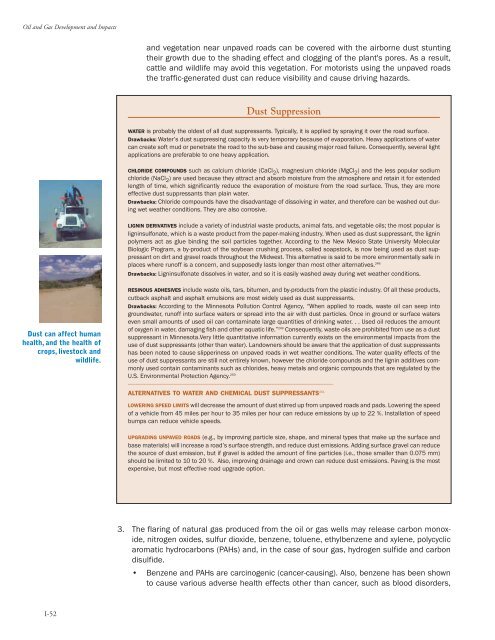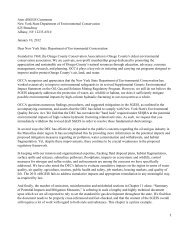Oil and Gas at Your Door? (2005 Edition) - Earthworks
Oil and Gas at Your Door? (2005 Edition) - Earthworks
Oil and Gas at Your Door? (2005 Edition) - Earthworks
Create successful ePaper yourself
Turn your PDF publications into a flip-book with our unique Google optimized e-Paper software.
<strong>Oil</strong> <strong>and</strong> <strong>Gas</strong> Development <strong>and</strong> Impacts<br />
<strong>and</strong> veget<strong>at</strong>ion near unpaved roads can be covered with the airborne dust stunting<br />
their growth due to the shading effect <strong>and</strong> clogging of the plant's pores. As a result,<br />
c<strong>at</strong>tle <strong>and</strong> wildlife may avoid this veget<strong>at</strong>ion. For motorists using the unpaved roads<br />
the traffic-gener<strong>at</strong>ed dust can reduce visibility <strong>and</strong> cause driving hazards.<br />
Dust Suppression<br />
WATER is probably the oldest of all dust suppressants. Typically, it is applied by spraying it over the road surface.<br />
Drawbacks: W<strong>at</strong>er’s dust suppressing capacity is very temporary because of evapor<strong>at</strong>ion. Heavy applic<strong>at</strong>ions of w<strong>at</strong>er<br />
can cre<strong>at</strong>e soft mud or penetr<strong>at</strong>e the road to the sub-base <strong>and</strong> causing major road failure. Consequently, several light<br />
applic<strong>at</strong>ions are preferable to one heavy applic<strong>at</strong>ion.<br />
CHLORIDE COMPOUNDS such as calcium chloride (CaCl 2 ), magnesium chloride (MgCl 2 ) <strong>and</strong> the less popular sodium<br />
chloride (NaCl 2 ) are used because they <strong>at</strong>tract <strong>and</strong> absorb moisture from the <strong>at</strong>mosphere <strong>and</strong> retain it for extended<br />
length of time, which significantly reduce the evapor<strong>at</strong>ion of moisture from the road surface. Thus, they are more<br />
effective dust suppressants than plain w<strong>at</strong>er.<br />
Drawbacks: Chloride compounds have the disadvantage of dissolving in w<strong>at</strong>er, <strong>and</strong> therefore can be washed out during<br />
wet we<strong>at</strong>her conditions. They are also corrosive.<br />
LIGNIN DERIVATIVES include a variety of industrial waste products, animal f<strong>at</strong>s, <strong>and</strong> vegetable oils; the most popular is<br />
ligninsulfon<strong>at</strong>e, which is a waste product from the paper-making industry. When used as dust suppressant, the lignin<br />
polymers act as glue binding the soil particles together. According to the New Mexico St<strong>at</strong>e University Molecular<br />
Biologic Program, a by-product of the soybean crushing process, called soapstock, is now being used as dust suppressant<br />
on dirt <strong>and</strong> gravel roads throughout the Midwest. This altern<strong>at</strong>ive is said to be more environmentally safe in<br />
places where runoff is a concern, <strong>and</strong> supposedly lasts longer than most other altern<strong>at</strong>ives. 248<br />
Drawbacks: Ligninsulfon<strong>at</strong>e dissolves in w<strong>at</strong>er, <strong>and</strong> so it is easily washed away during wet we<strong>at</strong>her conditions.<br />
Dust can affect human<br />
health, <strong>and</strong> the health of<br />
crops, livestock <strong>and</strong><br />
wildlife.<br />
RESINOUS ADHESIVES include waste oils, tars, bitumen, <strong>and</strong> by-products from the plastic industry. Of all these products,<br />
cutback asphalt <strong>and</strong> asphalt emulsions are most widely used as dust suppressants.<br />
Drawbacks: According to the Minnesota Pollution Control Agency, “When applied to roads, waste oil can seep into<br />
groundw<strong>at</strong>er, runoff into surface w<strong>at</strong>ers or spread into the air with dust particles. Once in ground or surface w<strong>at</strong>ers<br />
even small amounts of used oil can contamin<strong>at</strong>e large quantities of drinking w<strong>at</strong>er. . . Used oil reduces the amount<br />
of oxygen in w<strong>at</strong>er, damaging fish <strong>and</strong> other aqu<strong>at</strong>ic life.” 249 Consequently, waste oils are prohibited from use as a dust<br />
suppressant in Minnesota.Very little quantit<strong>at</strong>ive inform<strong>at</strong>ion currently exists on the environmental impacts from the<br />
use of dust suppressants (other than w<strong>at</strong>er). L<strong>and</strong>owners should be aware th<strong>at</strong> the applic<strong>at</strong>ion of dust suppressants<br />
has been noted to cause slipperiness on unpaved roads in wet we<strong>at</strong>her conditions. The w<strong>at</strong>er quality effects of the<br />
use of dust suppressants are still not entirely known, however the chloride compounds <strong>and</strong> the lignin additives commonly<br />
used contain contaminants such as chlorides, heavy metals <strong>and</strong> organic compounds th<strong>at</strong> are regul<strong>at</strong>ed by the<br />
U.S. Environmental Protection Agency. 250<br />
----------------------------------------------------------------------------------------------------------------------------------<br />
ALTERNATIVES TO WATER AND CHEMICAL DUST SUPPRESSANTS 251<br />
LOWERING SPEED LIMITS will decrease the amount of dust stirred up from unpaved roads <strong>and</strong> pads. Lowering the speed<br />
of a vehicle from 45 miles per hour to 35 miles per hour can reduce emissions by up to 22 %. Install<strong>at</strong>ion of speed<br />
bumps can reduce vehicle speeds.<br />
UPGRADING UNPAVED ROADS (e.g., by improving particle size, shape, <strong>and</strong> mineral types th<strong>at</strong> make up the surface <strong>and</strong><br />
base m<strong>at</strong>erials) will increase a road’s surface strength, <strong>and</strong> reduce dust emissions. Adding surface gravel can reduce<br />
the source of dust emission, but if gravel is added the amount of fine particles (i.e., those smaller than 0.075 mm)<br />
should be limited to 10 to 20 %. Also, improving drainage <strong>and</strong> crown can reduce dust emissions. Paving is the most<br />
expensive, but most effective road upgrade option.<br />
3. The flaring of n<strong>at</strong>ural gas produced from the oil or gas wells may release carbon monoxide,<br />
nitrogen oxides, sulfur dioxide, benzene, toluene, ethylbenzene <strong>and</strong> xylene, polycyclic<br />
arom<strong>at</strong>ic hydrocarbons (PAHs) <strong>and</strong>, in the case of sour gas, hydrogen sulfide <strong>and</strong> carbon<br />
disulfide.<br />
• Benzene <strong>and</strong> PAHs are carcinogenic (cancer-causing). Also, benzene has been shown<br />
to cause various adverse health effects other than cancer, such as blood disorders,<br />
I-52




